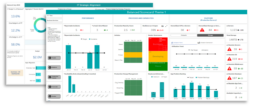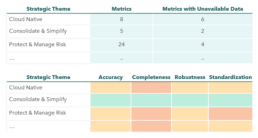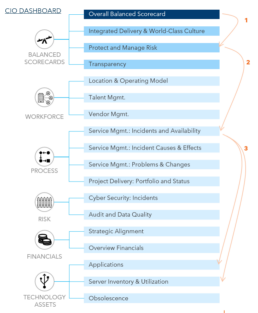Introduction
A CIO leading a multi-billion-dollar digital transformation wisely defines her remit as delivering “scale, speed, security, and stability”. That, of course, defines desired outcomes from the hundreds of initiatives categorized under buzzwords like “projects to products”, “going agile”, “cloud native”, “analytics & AI/ML”, “customer first”, and “consolidate & simplify”. These themes overlap with regular themes like stability & resiliency, delivery excellence, and workforce effectiveness.
CIOs and other digital leaders thus face two challenges
- How does one inspire an organization to transform when these objectives/concepts are so nebulous and uncertain?
- How can one build momentum & track progress across their organizations against such fuzzy objectives?
CIOs often address these challenges by turning to metrics and dashboards to increase the clarity & specificity of objectives, build momentum & track progress. In essence, just like airline pilots, they want a cockpit instrument panel to help manage the transformation journey.
Building such an instrument panel (“digital dashboard”) requires answering 4 sets of questions
A.What exactly do the themes mean for their firms, and how do they manifest as metrics? What are their relative priorities?
- Identical themes may manifest differently across companies given their respective starting points, destinations, and specific journeys to those destinationsB.Does the data driving these metrics exist in a usable form? What is the quality of that data? What proxies/ approximations will suffice?
- Most IT organizations are, ironically, not well endowed with information about themselves, particularly so about new or nascent concepts (e.g., going Agile).
C.How can the dashboards be designed to be insightful, useful, and widely adopted? What does good or good enough look like?
D.What are the approaches to building, evolving, and sustaining them over time?
As we shall see, building effective dashboards that help executives drive such complex agendas requires insight and analytical depth, creativity, deep executive engagement, and a product management mindset, all of which make this different from “regular” operational dashboards.
Exhibit 1. CIO Dashboard Samples
Manifesting Transformation Themes
Digital transformation themes & objectives should reflect priorities as shared in company strategy and investor communications; other themes can often be grouped under the new themes, reframed, or deprioritized, but clarity and alignment on the final themes and their hierarchy are critical. Depending on the context, themes can vary in their specificity & aspiration. For example, the left side of Exhibit 2 illustrates a scenario where platform stability was the overarching criterion, while the right side illustrates a case where large-scale organizational transformation was the key objective.
Ambiguous themes/objectives often require brainstorming sessions with senior executives for clarity & alignment to emerge amongst the executives themselves. For instance, “agility” can mean Agile metrics (like backlog health) and/or greater responsiveness of the organization (e.g., age of open positions).
Summarizing these themes/categories and metrics into a “metrics tree” then defines the aspiration for the digital dashboard, which will then be prioritized & realized over several iterations. Judging how broad and deep such a tree should be to be useful requires effective buy-in from senior leadership.
Exhibit 2. Organizational Imperatives Drive Transformation Themes & Metrics
Data Availability and Quality
Most IT organizations struggle with capturing, analyzing, and using information about themselves, even for regular operational functions. As a result, many IT functions often lag their business and operations partners in the use of analytical data to drive decisions. IT leaders are often acutely aware of that situation but struggle to overcome the underlying causes within their functions: fragmented, less mature processes and systems, and the qualitative (as opposed to quantitative) nature of decision-making.
Even when data exists, they may not be deemed robust. Hence, assessing the source, quality & frequency of the data underlying the selected metrics is important to build trust in them when they are presented. We have found that including metrics on data quality itself becomes a key component of building credibility for the dashboard and simultaneously increasing the organization’s maturity; Exhibit 3 illustrates such metrics and the implied level of maturity of the function/process. A key benefit of dashboards is insight arising from the integration of multiple data sources; that integration, however, is often impeded by the lack of standardization of key terms and data (e.g., which projects are really “strategic”), and of actual linkages across data sets (e.g., which servers map to which applications).
In many cases, the metrics and data are truly new for the organization, e.g., it is hard to have metrics on Agile performance if one just started the journey. In such cases, alternate and proxy metrics can be used in the early stages, to be superseded later by “proper” metrics with more robust data.
In the end, it is the availability and quality of the data that will determine which themes are manifested by which metrics (and by when). Aligning with the CIO team on a real metrics tree (as opposed to an idealized one) is key to setting the right expectations and providing a firm basis for the design and build of the CIO dashboard.
Exhibit 3. Data Quality Metrics
Designing for Insight and Adoption
Most people find it hard to specify what they want when it comes to data visualizations but can easily judge whether a visualization is insightful or useful. For CIO dashboards, deep experience in IT strategy becomes key to selecting meaningful metrics and effectively designing visualizations. In our experience, effective dashboards also
- Share information hierarchically. A “one page” balanced scorecard is followed by theme-specific and then function-specific metrics
- Allow executives to interrogate the dashboards via filters, drill-downs, etc. Insightful dashboards raise many questions, and to be more effective, they allow the CIO to answer “why” at 2-3 levels of depth (enough to identify whom to call to address the issue). Exhibit 4 illustrates such a scenario where the CIO team proceeds from the “landing page” of the CIO dashboard to theme-specific details and then to deeper functional levels, all within the same dashboard (via different tabs and links)
- Address key economics of the IT functions, e.g., finances, operating models (people, vendors, locations), projects, and assets
The most important element for adoption is, of course, for the CIO to normalize the use of the dashboard in regular review and decision processes, both in group and individual settings. Cascading select metrics and dashboards deeper into the organization will also make transformation real for others. In all cases, it is important to remember how anxiety-inducing clarity & transparency of performance can be for people.
Exhibit 4. Effective CIO Dashboards Answer “Why” at 3 levels
Building and Sustaining a CIO Dashboard
Creating CIO dashboards involves simultaneously addressing the ambiguity of objectives & intent, the absence of key data, and the need for insightful presentation. Successful deployment of CIO dashboards requires a combination of a strategic mindset with product management discipline, along with support from the CIO. It also requires rapid but iterative delivery of dashboard features to build momentum for its usage and its underlying data processes.
Initial versions of CIO dashboards often generate a lot of interest and excitement, as data and analysis executives “always wanted” is presented in an integrated and useful way. And even early versions of dashboards can quickly help identify and drive meaningful changes in the organization. In our experience, visualizations showing the extent of underutilization of infrastructure assets or the degree of fragmentation of the delivery model quickly start to drive changes in behavior.
Delivering the full promise of the dashboard, however, requires addressing the barriers to the availability of robust data underlying the metrics. Those barriers can be across systems, processes, or data management, and require concerted efforts to break through. For example, data for Agile metrics may be originating in Jira, but that data may not have been fed into the data warehouses on a normal basis.
Or, data may not exist within the IT function and would need to be brought in, e.g., data on external resources from offshore firms (by role, location, project/product, etc.) which would be key to understanding the fragmentation of the operating model.
Building the plumbing to integrate and “productionalize” the data sources for the CIO dashboard can be a material effort, but it pays quick dividends, not least in increasing the maturity of the IT function as a whole. In a sense, the instrument panel prevents one from “flying blind” during the transformation.
Three additional factors sustain the CIO dashboard over time
- Applying the same product management discipline to the dashboards as that for any other product: ensuring ongoing & increasing usage by the CIO team and evolution of the metrics, data feeds, and visualizations to support emerging needs
- Cascading relevant parts of the dashboards further down the organization to build greater alignment, make the transformation more tangible and demonstrate that data being generated across IT is to be taken as seriously as any other.
- Incorporating these dashboards into the discussions of the CEO team, the Board, and even regulators will embed the dashboards in the organization and drive improved perceptions of IT function maturity and capability
In Closing..
Tracking transformative change is difficult by definition – the direction & destination may be ambiguous, and the data needed may not exist because the organization may not have ever done what is being asked for now. While the need for an instrument panel to help guide and manage the transformation journey may be obvious, building one requires strategic insight, analytical depth, creativity, deep executive engagement, and a product management mindset.
Today, every C-level executive needs an insightful dashboard to help navigate the business. Some firms are lacking data, and others are overloaded with information that is not ‘actionable’.
A simple, effective, insightful, predictive C-level dashboard and the right management processes (for performance and execution management) separate the winners from others.
__________________________________________________________________________________________________________
































